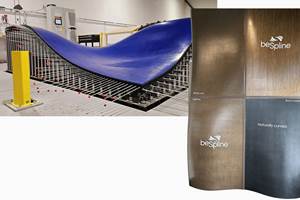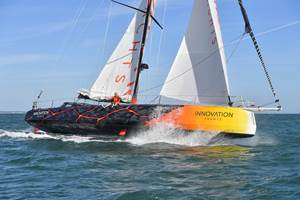In defense of glass fiber
Given the hype around carbon fiber, CW columnist Dale Brosius says it's easy to overlook the importance and future of glass fiber.
I just returned from Paris and the annual JEC show, held in a new location and, to my surprise and delight, very well attended given the distance from central Paris. The event’s environment was as dynamic as I’ve ever seen it, a strong reflection on the optimism in the composites industry today. What struck me particularly this year were the endless displays of molded carbon fiber parts — on the various exhibition stands and throughout the various new “Planets” organized by JEC to feature parts or assemblies. Although one would expect the Aero Planet would be dominated by carbon fiber structures, the Auto Planet was probably greater than 90% carbon fiber parts.
On reflection, I wonder how many of these floor pans, side frames, hoods and roofs are simply technology demonstrators or proofs of concept? How many of them are truly headed for serial production? I suspect most
are the former, because there have not been that many capacity expansions announced recently by carbon fiber manufacturers, and large automotive programs that incorporated parts of this size would certainly drive the need for more capacity. Costs of carbon fiber components still need to come down significantly.
At JEC, I also had meetings with several of the fiberglass suppliers, whose business seems fairly brisk in today’s environment. Given all the hype around carbon fiber, it’s easy to overlook the importance of glass fiber and the future of this very pervasive reinforcement. Admittedly, I write a lot about carbon and
its potential future, but I think we should also give fiberglass its rightful place in the spotlight. Without it, the composites industry as we know it would be dramatically smaller in size.
To put things in proportion, the global market for fiberglass used in composites is approximately 5 million MT per annum, while estimates on the high end for carbon fiber put it around 80,000 MT per annum, or less than 2% of the market size for glass fiber. This is a substantial difference in scale! Which probably explains why we so easily treat glass as a commodity material. Glass is the predominant fiber in composite materials used in corrosion-resistant pipes and tanks, bridge decks, boats and wind turbine blades. It’s also the dominant reinforcement for automotive composites that are actually in production, especially when one considers SMC and thermoplastic injection molding compounds. In aerospace, too, most of the panels that form the interior cabins of commercial aircraft are based on fiberglass.
Glass fiber offers many design advantages, especially considering its relatively modest cost. It is much stronger than steel in tensile strength, and almost as strong as industrial-grade carbon fiber. Its high elongation (roughly 5% strain-to-failure for E-glass, compared to carbon at 1.5-2.0%) enables structures to absorb greater impacts or abrasive forces when paired with high-elon- gation resins. In fiberglass composites, the coefficient of thermal expansion can be tailored to be closer to that of aluminum and steel, making it a good candidate for metal/composite structures that see fluctuations in temperature. And the molecular structure of the glass itself makes it more amenable to various coupling agents and sizings. This improves glass fiber’s adhesion to a broad variety of polymers.
To be fair, at JEC I did see several innovative applications of fiberglass composites in automotive. One was a liftgate inner panel with woven glass inserts in critical impact and stress areas, overmolded via injection molding with glass-filled thermoplastic. I believe the field of structural injection overmolding may be a better fit for fiberglass than for carbon, at least for the next 5-10 years. Another part that caught my eye was an ultralow-density glass SMC outer panel combined with a thin, carbon fiber inner panel for a hood assembly. This concept of using carbon fiber selectively as stiffening elements in conjunction with glass fiber is not new — wind blade manufacturers often use carbon fiber spar caps in longer blades. Such blades are still 95% fiberglass by reinforcement type. I think we should make more effort to explore glass/carbon hybrid structures to achieve better cost/performance ratios.
Although there are many varieties of carbon fiber, today we mainly use E-glass with a small amount of S-2 glass. Based on my conversations with glass suppliers, there are further opportunities to create glass fibers with targeted properties at a price point between E-glass and S-glass. I, for one, would like to see more development in new glass formulations that can open markets for which carbon fiber composites are clearly too expensive. And if we use the approach of hybridization, we’ll open up the market for carbon as well.
Institute for Advanced Composites Manufacturing Innovation (IACMI)
Related Content
Plant tour: BeSpline/Addcomp, Sherbrooke, QC, Canada
Composites automation specialist increases access to next-gen technologies, including novel AFP systems and unique 3D parts using adaptive molds.
Read MoreEuropean boatbuilders lead quest to build recyclable composite boats
Marine industry constituents are looking to take composite use one step further with the production of tough and recyclable recreational boats. Some are using new infusible thermoplastic resins.
Read MoreAnemoi installs 35-meter-tall composite rotor sails on Sohar Max maritime vessel
Carbon fiber-reinforced epoxy composites are key to building these long-lasting wind propulsion technologies for energy-efficient watercraft.
Read MoreAl Seer Marine, Abu Dhabi Maritime unveil world’s largest 3D-printed boat
Holding the new Guinness World Record at 11.98 meters, the 3D-printed composite water taxi used a CEAD Flexbot to print two hulls in less than 12 days.
Read MoreRead Next
Next-gen fan blades: Hybrid twin RTM, printed sensors, laser shock disassembly
MORPHO project demonstrates blade with 20% faster RTM cure cycle, uses AI-based monitoring for improved maintenance/life cycle management and proves laser shock disassembly for recycling.
Read MoreScaling up, optimizing the flax fiber composite camper
Greenlander’s Sherpa RV cab, which is largely constructed from flax fiber/bio-epoxy sandwich panels, nears commercial production readiness and next-generation scale-up.
Read MoreUltrasonic welding for in-space manufacturing of CFRTP
Agile Ultrasonics and NASA trial robotic-compatible carbon fiber-reinforced thermoplastic ultrasonic welding technology for space structures.
Read More











